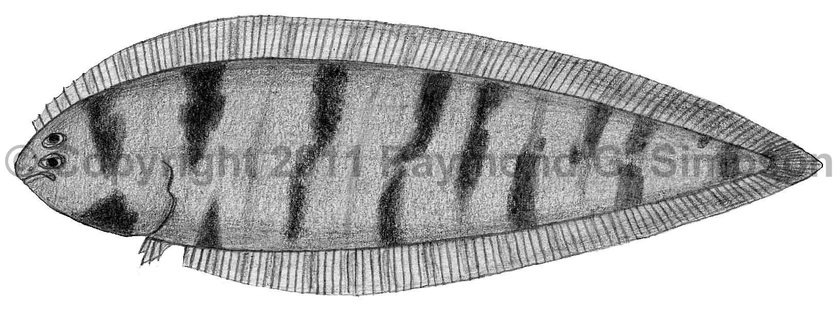
Common Name
Tessellated Tonguefish
Year Described
Quoy and Gaimard, 1824
Identification
Dorsal Fin Rays: 91-102
Anal Fin Rays: 74-86
Pectoral Fin Rays: none
Pelvic Fin Rays: 4
Caudal Fin Rays: 12
Longitudinal Scale Rows: 81-96
Vertebrae: 48-54
Pterygiophore pattern (1st three interneural spaces): 1-4-3
Other diagnostic characters include: pupillary operculum absent, ocular side lower jaw without fleshy ridge, and 4-8 scales present on blind side dorsal and anal fin rays (most obvious in large specimens on posterior third of fins).
Color
Varying shades of brown with 5-9 distinct, dark brown crossbands on body. Ventral margin of opercle with a dark blotch present. Inner lining of opercle also darkly pigmented. Dorsal and anals fins grading from dusky to very dark on the rear part of fin (males darker than females). Caudal fin dark to black. Peritoneum unpigmented. Blind side cream without melanophores, but some large males have patches of black pigment in the caudal region.
Size
Mature adults from 100-190mm. Maximum size to 220mm.
Habitat
Shallow waters from 1-86m (usually <50m), over soft bottoms. Juveniles frequently in estuaries, but only in high salinity areas.
Range Map

Range
Widespread from the Caribbean Sea to Argentina. Not from the mainland U.S.
References
Munroe, T.A. 1998. Systematics and ecology of western Atlantic tonguefishes (Symphurus: Cynoglossidae: Pleuronectiformes). Fish. Bull. 96(1):1-182.
Munroe, T. A. 2003. Bothidae (Pp. 1885-1895), Scophthalmidae (Pp. 1896-1897), Paralichthyidae (Pp. 1898-1921), Poecilopsettidae (Pp. 1922-1923), Achiridae (Pp. 1925-1933), Cynoglossidae (Pp. 1934-1959). In: Carpenter. 2003. The living marine resources of the Western Central Atlantic v. 3.